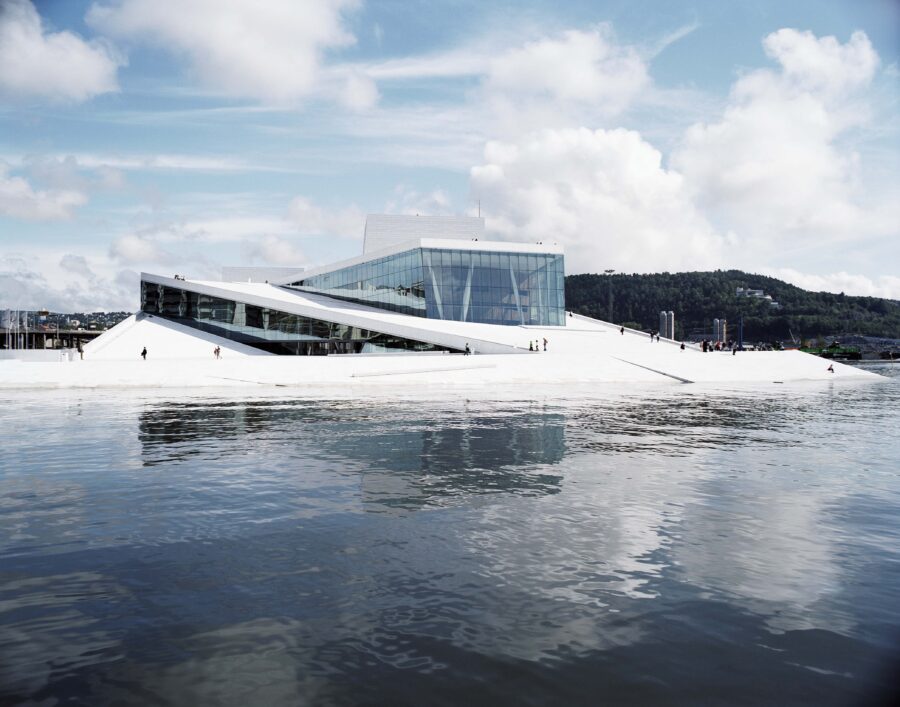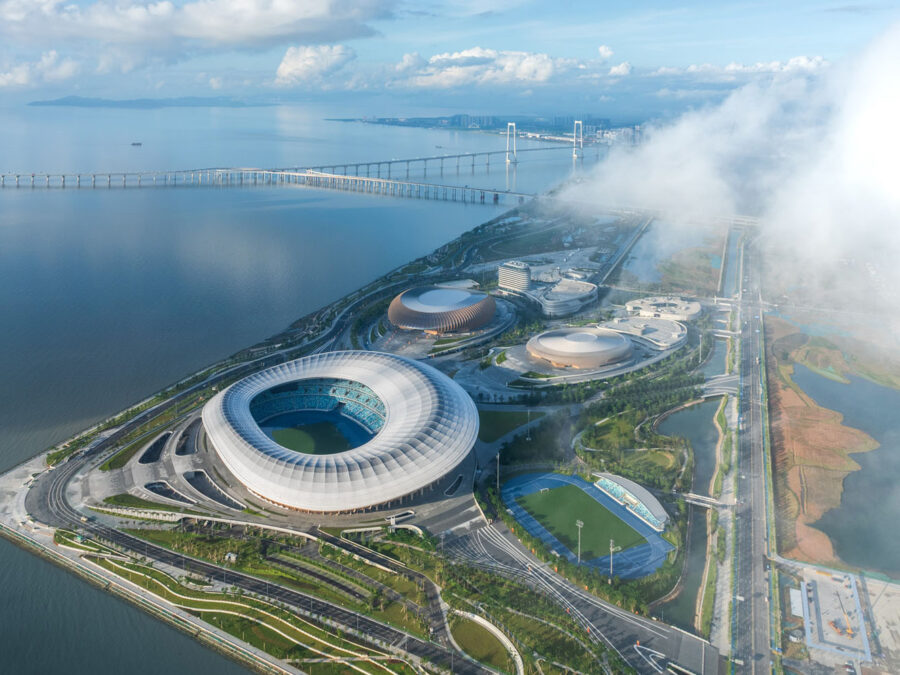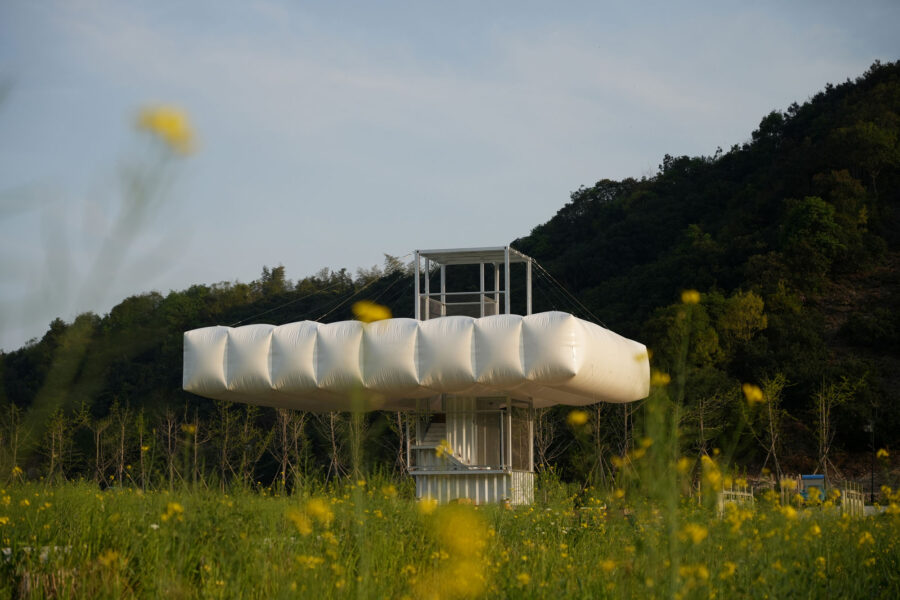
CULTURE


© Yumeng Zhu
オスロ、パリ、インスブルック、ニューヨーク、サンフランシスコ、香港、深圳、アデレード、メルボルンと世界各地にスタジオを構え、世界的に活躍するスノヘッタ(Snøhetta)が中国、北京に設計した〈北京都市図書館(Beijing City Library)〉がオープンしました。デジタル時代における、コミュニティ・スペースとして設計された図書館です。
中国原産のイチョウの葉をモチーフにした細長い柱で支えられたガラス張りの建物であり、渓谷と丘のような曲線的な階段状のテラスが、周囲に広がる風景へと訪問者の視線を誘導します。
(以下、Snøhettaから提供されたプレスキットのテキストの抄訳)

© Yumeng Zhu

© Yumeng Zhu
スネヘッタによる〈北京都市図書館〉は、学習、知識の共有、交流のための現代的で忘れがたい場所を、北京の豊かな文化的・知的シーンに挿入する。
この新たな図書館は、北京の副都心に指定された、首都の東の玄関口ともみなされる通州区に位置する。区に建てられた3つの新たな主要文化施設の1つである〈北京都市図書館〉は、通州を活気ある地区として、そして北京という都市の延長として確立している。

© Yumeng Zhu
同地区の野心的なマスタープランを支えるものであり、比較的未開発の地域から、活気ある芸術・文化の発信地へと変貌を遂げるきっかけとなるだろう。北京中心部への新たな交通アクセスも整備されつつあり、通州区はより一層北京市と一体化し、副都心への観光客誘致が期待されている。
スノヘッタは2018年、国際コンペを通じて〈北京都市図書館〉を受注し、現地パートナーであるECADIとともにプロジェクトを完成させた。

© Yumeng Zhu
デジタル時代における図書館の復権
10数年前、図書館は、デジタル化によっていつでもどこでも情報にアクセスできるようになったため、消滅しつつある存在だと考えられていた。スノヘッタは、21世紀における図書館を復活させるため、図書館の外観、働き方、コミュニティへのサービスのあり方について新たなビジョンを提示することに着手した。
〈北京都市図書館〉は、周囲に広がる丘、木々、川という絵のように美しい環境の中で、本というオブジェクトの物理的な性質と、書かれた言葉を取り入れるためにページをめくるという意識的な運動に焦点を当てている。

© Yumeng Zhu
スノヘッタの共同設立者でありパートナーであるシェティル・トレーダル・トールセン(Kjetil Trædal Thorsen)は次のように語る。
「デジタル時代にも図書館が生き延びるために必要なもの、それは人々の本に対する愛情である。スクリーンを離れて読書の喜びを再び呼び起こすために、身体と心、そして周囲の関係を私たちが再解釈することで、図書館はこれからも存在するのである。」

© Yumeng Zhu
公共生活と知的生活の重要な柱としての図書館の役割を再び確立し、単なる本の保管庫以上の存在となるために、スノヘッタはこの図書館を学習、文化、コミュニティの中心地と位置づけた。図書館がその時代と場所のニーズに革新的な対応を見出してきた歴史的な起源に基づき、〈北京都市図書館〉は開かれたアイデアの交換と人間同士の対話を目的の中心に据えている。
建物には全体を通して、展示、パフォーマンス、会議、古書の修復のための専用スペースが設けられている。この建物は、本、人々、そしてその向こうに広がる自然の風景との間に感情的なつながりを育むことで、図書館が廃れたタイポロジーになるという議論を、多くの可能性を生み出すことで否定している。

© Yumeng Zhu
スノヘッタのパートナーであり、アジア太平洋地区ディレクターであるロバート・グリーンウッド(Robert Greenwood)は次のように語る。
「図書館が社会で果たす役割や、人々が図書館を利用する方法は大きく変化している。図書館は今、活気あるコミュニティ・スペースとして機能し、社会的交流や知識の共有を可能にすることが求められているのである。」

© Yumeng Zhu
図書館の中に彫刻する渓谷と丘
ガラス張りの建物は、読書スペースに自然を招き入れ、豊かな内部環境に透明性を与えている。図書館の中心には高さ約16mの広々としたウェルカム・フォーラムがあり、そこから滑らかでリズミカルな曲線に沿って階段状のテラスが伸びている。
中央を貫く「渓谷」と名付けられた蛇行した小道は、建物の主要な回遊動線となっている。渓谷は近くを流れる通恵河の流れを反映し、外側に広がる風景をシームレスに体験させ、南北のエントランスを結んで内部のさまざまなスペースへと訪問者を導いている。

渓谷からそびえ立つ段々畑のような丘は、彫刻のような地形を内部につくり出し、地面、座席、棚として機能するようにデザインされている。半個室の読書エリアと会議室は丘に埋め込まれ、書庫とテーブル席は頂上のフラットな場所に設置されている。この中央のオープンエリアはどこからでもアクセス可能であり、世界最大級の書籍自動保管・検索システムが組み込まれている。
渓谷のスケールと本のスケールをつなげる大空間を際立たせているのは、イチョウの葉の形をした平らなパネルにキノコのような形状の細長い柱である。重なり合うパネルとガラスで構成された屋根により、フィルタリングされた陽の光が室内に降り注ぐ。

© Yumeng Zhu
このイチョウの天蓋の下で、人は本の渓谷とその向こうに広がる広大な風景の地平線を見下ろす頂上に到達することができる。周囲との一体感や、本から想像される世界との一体感を体験することで、読者はその場所ならではの思い出をつくることができる。
建物の北端と南端には本物のイチョウの木が植えられており、丘は眺望を外側に集中させ、自然とのつながりをさらに高めている。この図書館は、読書、パフォーマンス、景観を一体化させることで、北京の自然と文化遺産を称えている。

© Yumeng Zhu
持続可能なテクノロジーにより確立する図書館のグリーンスタンダード
〈北京都市図書館〉は、来館者の体験を向上させる最先端技術を取り入れながら、今日の図書館が差し迫った気候変動問題にどのように対処できるかを再考している。この建物は、建設と運用にまつわる炭素の両方を最小限に抑えることで、中国における最高のサステナビリティ基準であるGBELスリースターを達成した。
モジュール式のコンポーネントの使用と合理化された構造グリッドは、建物の製造廃棄物を削減する。イチョウの木の柱は、単一のモジュールタイプを回転させ、9×9mのグリッド上に配置することで、バラエティに富んだ外観を与えながら、効率的な製作と施工を可能にしている。

© Yumeng Zhu
また、これらの柱には、室内の気候、照明、音響を制御する技術が統合されているほか、屋上の雨水を集め、灌漑に再利用することもできる。
ゆったりとした屋根の張り出しにより、ガラスファサードの日射取得を低減するなど、サステナビリティに妥協することなく、重要なデザイン要素を達成している。ファサードをさらに最適化するため、東と西の窓のガラスの高さを低くし、断熱性の高いLow-Eガラスを使用している。
屋根には、従来の屋根材やファサード材のように使用できる太陽光発電建築部材が組み込まれており、屋上という太陽光への絶好の露出を再生可能エネルギーの生産に活用している。

© Yumeng Zhu

© Yumeng Zhu

© Yumeng Zhu
以下、Snøhettaのリリース(英文)です。
Snøhetta unveils the world’s largest climatized reading space with their new Beijing City Library
Snøhetta’s Beijing City Library has opened doors for visitors as the world’s largest climatized reading space. It is the firm’s latest innovation in the library typology, thirty-five years after they began work on Bibliotheca Alexandrina in Egypt. The project introduces a contemporary yet indelible place for learning, knowledge-sharing, and socializing to Beijing’s rich cultural and intellectual scene.
The new library is located in Tongzhou District, a designated sub-center of Beijing that is often considered the eastern gateway of the capital. As one of three new major cultural buildings in Tongzhou, the Beijing City Library further establishes the area as both a vibrant district in itself and an extension of Beijing’s urban fabric. It anchors the neighborhood’s ambitious masterplan and will help to catalyze its transformation from a relatively undeveloped area into a lively arts and cultural destination. New transit links to Beijing’s center are underway, promising to further integrate Tongzhou with the city and drive visitors to the sub-center.
Snøhetta was awarded the Beijing City Library in 2018 through an international competition and the project was completed with local partner ECADI. The firm is currently working on three libraries in the United States: Charlotte Mecklenburg Library, Far Rockaway Library, and Westchester Square Library.
Reinstating the Library’s Relevance in the Digital Age
A decade or so ago, libraries were thought to be a disappearing typology as digitization has increasingly made information accessible at any time and place. To reinstate the library’s relevance in the 21st century, Snøhetta set out to offer a new vision for how it looks, works, and serves the community. The Beijing City Library draws focus on the physicality of a book as an object and the conscious exercise of turning the pages to take in the written word as the primary experience amidst the picturesque setting of hills, trees, and the Tonghui river.
“It is the love people have for books that has made libraries survive the digital age and hold new potential to give back more to the city and its public”, notes Kjetil Trædal Thorsen, Co-Founder and Partner at Snøhetta. “It is up to us to reinterpret the relationship between body, mind, and the surroundings to rekindle the joy of reading away from the screen. Libraries are here to stay.”
To reestablish the library’s role as an important pillar of public and intellectual life, and become more than a mere repository of books, Snøhetta has positioned the building as a center for learning, culture, and community. Drawing on the historical origins of libraries finding innovative responses to the needs of their time and place, Beijing City Library makes the open exchange of ideas and human dialogue its core purpose. Throughout, there are dedicated spaces for exhibitions, performances, conferences, and the restoration of ancient books. The building firmly rejects the argument of the library becoming a derelict typology with the numerous possibilities it creates, by fostering an emotional connection between books, people, and the natural landscape beyond.
“The role libraries play in society and the way people use them has vastly changed,” says Robert Greenwood, Partner and Director of Asia Pacific at Snøhetta. “They are now needed to function as vibrant community spaces, enabling social interaction and knowledge-sharing.”
Sculpting the Valley and the Hills within the Library
The glass-lined building invites nature into the reading space and lends transparency to the enriched interior environment when viewed from outside. At the heart of the library is a sweeping, nearly 16-meter-tall welcoming forum off of which rise stepped terraces along smooth, rhythmic curves. Carved through the center is a meandering pathway called the Valley, which serves as the main circulation artery of the building. The Valley mirrors the course of the nearby Tonghui river, seamlessly continuing the experience of the landscape beyond and linking the north and south entrances to lead visitors to all other spaces inside.
The terraced hills rising from the Valley are designed to create a sculpted interior landform that serves as the ground, seating, and shelving—an informal zone with opportunities to relax, talk, or read quietly, all while staying connected to the larger space. Semi-private reading areas and conference rooms are embedded into the hills, while book stacks and table seating are set on long, flat areas atop. This central open area is fully accessible and incorporates one of the largest book Automated Storage and Retrieval Systems (ASRS) in the world.
Punctuating the large space to transition between the scale of the Valley and the books are tall, slender columns that mushroom into flat panels shaped like ginkgo leaves—referencing a 290-million-year-old tree species native to China. The overlapping panels and the interstitial glass inserts create a canopy-like roof that floods the interiors with filtered daylight. Under this ginkgo canopy, one can reach the summit that overlooks the valley of books and the horizon of the vast landscape beyond. This experience of oneness with the immediate surroundings and the imagined world offered in books allows the reader to forge memories that are unique to the place.
“The terraced landscape and tree-like columns invite visitors to lift their gaze and focus at a distance, taking in the bigger picture. This is a place where you can be sitting under a tree, reading your favorite book”, says Greenwood. “The Beijing City Library has an intergenerational quality about it, where you would pass on your stories to children and introduce them to the titles you’ve loved.”
At the northern and southern edges of the building where real ginkgo trees are planted at the entry points, the hills focus their views outwards to further enhance the connection with nature. The library celebrates Beijing’s natural and cultural heritage by integrating reading, performance, and landscape together.
Setting the Green Standard for Libraries with Sustainable Technology
The Beijing City Library rethinks how libraries today can address the pressing climate challenges while incorporating cutting-edge technology to improve visitor experience. The building achieved China’s GBEL Three Star, the highest attainable sustainability standard in the country, by minimizing both embodied and operational carbon. The project is as much a steward of its environment as of the communities it serves.
The use of modular components and a rationalized structural grid reduces the manufacturing waste for the building. For the ginkgo tree columns, a single module type is rotated on a 9x9m grid throughout the building to give the appearance of variety while being efficient to fabricate and install. These columns also house integrated technology to control interior climate, lighting, and acoustics, as well as collect rainwater from the roof to be reused for irrigation by channeling it to a green infrastructure system.
Generous roof overhangs reduce solar gain on the glass facades—currently the largest load-bearing glass system in China—achieving an important design element without compromising on sustainability. To further optimize the facade, the design reduces the height of the glass on the east and west wells and uses insulated low-E glass. The roof has integrated photovoltaic (BIPV) construction elements that replace the conventional roofing and facade materials, utilizing the prime exposure of the rooftop to sunlight for renewable energy production.
Project Facts
Project Name: Beijing City Library
Timeline: 2018-2023
Client: Beijing Planning and Natural Resource Bureau
Location: Beijing City Library, Lv Xin Road Courtyard No.1; Building No.3; Tongzhou District, Beijing
GFA: 75,000 sqm
Height: 22.3m
Status: Completed
Disciplines (by Snøhetta): Architecture, Interior Architecture
Typology: Library
Certification: Green Building Evaluation Label (GBEL)—“China Three Star”Collaborators:
Executive architect: ECADI
Structural, geotechnical, and civil engineer: ECADI
Cost Consultant: ECADI
Building sustainability engineer: ECADI
Façade & BMU engineer: Eckersley O’Callaghan, Meinhardt
Lighting designer: ECADI
Main Contractor: China Railway Construction Engineering GroupPhotography
Name (international media): Yumeng Zhu
Name (Chinese media): 朱雨蒙
Website: www.coppakstudio.com
Instagram: @yumeng_zhu_coppakstudioAbout Snøhetta
Snøhetta is a transdisciplinary practice that strives to enhance our sense of surroundings, collective identity, and relationship to others and the spaces we inhabit. We integrate architecture, landscape architecture, interior architecture, product design, and graphic & digital design to deliver projects across all scales and types.
From its inception in Norway in 1989, Snøhetta’s approach has been framed by environmental and cultural sensitivity, and further empowered by positive workplace guidelines for healthy labor practices.
Snøhetta’s first significant commission was the competition-winning entry to revive the ancient library in Egypt, Bibliotheca Alexandrina. This was followed by landmark projects such as the Norwegian National Opera and Ballet in Oslo and the National September 11 Memorial Museum Pavilion in New York City. Since then, we have expanded our reach across the globe and currently have several developments in Asia underway, including Shibuya Upper West in Tokyo, Cloud 11 in Bangkok, and the Grand Opera House in Shanghai.
Today, Snøhetta has more than 350 employees from 40 nations across nine regional studios in Oslo, New York, San Francisco, Innsbruck, Paris, Adelaide, Melbourne, Hong Kong, and Shenzhen.www.snohetta.com
「Beijing City Library」Snøhetta 公式サイト
https://www.snohetta.com/projects/beijing-city-library









